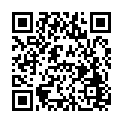KORG Gadget for Nintendo Switch
User Manual
Basic Operations
Basic Controller Operation
Save / Load Operations
Overview Screen Operation
Piano Roll Screen Operation
Gadget / Mixer Screen Operation
Play/Record Operations
Tech Glossary
Other Operations
Other Operations
Data Exchange
Settings
Oscilloscope
Options
Other Features
Other Features
External USB PC keyboard
Gadget Guide
Gadget List
Main Parameters
Synth Gadget
Drum Gadget
Effects
Basic Operations
Basic Controller Operation
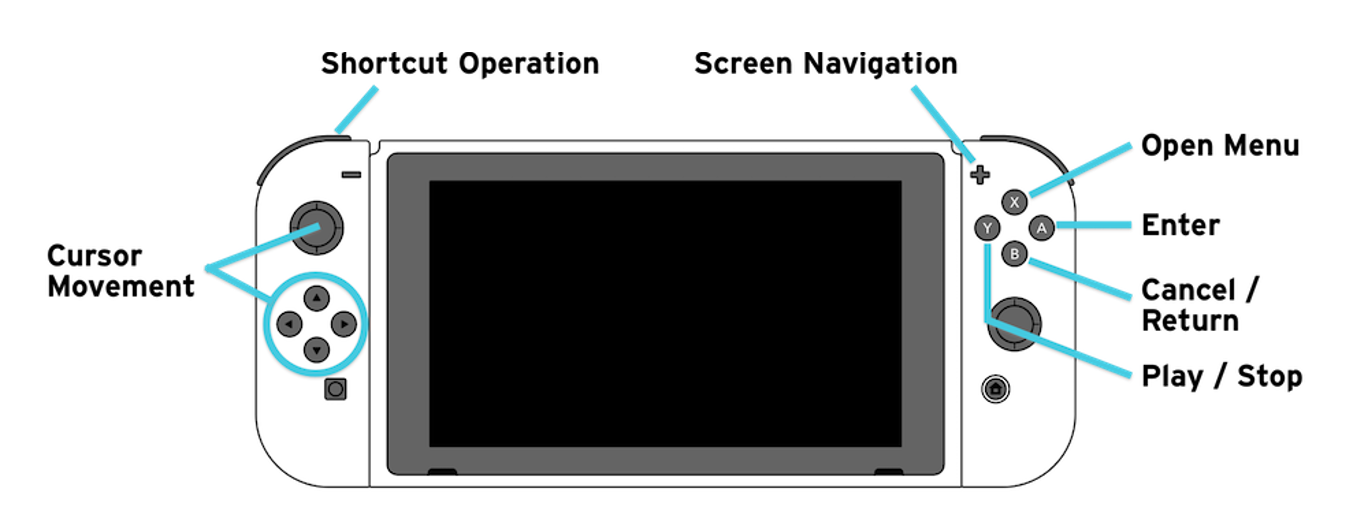
| Left Joystick / Direction Buttons |
Cursor Movement |
| A Button | Setting Used to select current item and to advance. |
| B Button | Cancel / Return Cancel the currently open menu and return to the previous screen. |
| X Button | Open Menu Opens the menu at the current cursor location. |
| Y Button | Play / Stop Start and stop a song. Long press initiates record mode, during which gadget performance and knob operations are recorded. |
| + Button | Screen Navigation Used to navigate between screens. |
| Select a Gadget at random A gadget is selected at random if you press the + button on the Gadget selection screen. |
|
| - Button | Motion performance and controller performance The motion performance and controller performance is started on the Gadget screen or Piano Roll screen. |
| L Button | Shortcut Operation Pressing this button causes the operations that can be performed on the current screen to be displayed. By pressing the appropriate button, the convenient functions can be accessed directly. |
| R Button | Moving between 4 screens In Four Screens mode, the cursor will appear and you can move between screens. |
| ZL Button | Adjust Note Length by the grid On the piano roll screen, you can adjust note length by the grid. |
| ZL Button | Select Range On the piano roll screen, you can select range. |
Save / Load Operations
From the overview screen, select “System” → “Save” or “System” → “Load” to save or load a song.
You can save up to 300 songs.
If multiple controllers are in use, save and load operations can only be used on Controller 1
Overview Screen Operations
View an entire song on this screen.

| Track |
Each vertical column makes up a part of a song, and corresponds to one gadget instrument. Arrange several gadget instrument tracks, such as drum track, bass track etc, to create a song. |
| Clip |
A “clip” is a sequence of notes. The gadget instruments on each track perform these notes during playback. Each track can be set individually, and the number of bars in each clip can vary. |
| Scene |
The horizontal blocks in each song represent scenes. The clips in each track are played back simultaneously. Songs are constructed by placing together a variety of scenes. For example, “Introduction”, “Melody A”, “Bridge” etc. |
Main Operations
| Move between gadget screen and piano roll |
Select the gadget icon on the top of the screen and press the A button to access the gadget screen. |
| Add Track / Scene |
Select the “+” icon at the top of the screen and then press the A button to add a track or scene. |
| Song Setting |
Select “Song Settings” from the menu to set the song title, tempo, and swing. |
| Setting and Editing Track / Scenes |
By selecting the gadget icon or scene and opening the menu, one can duplicate, delete, edit the name, move a track or a scene. When you select a scene, you can also set the display screen for Autoview. |
Convenient Functions
| Mute Clip / Unmute Clip |
You can mute/unmute the clip at the cursor. |
| Automatic Song Arranger |
Arrange the song automatically (only for the song with one scene) |
| Auto View |
Select from "Play/Record" in the menu. Play the song while displaying the screen set up for each scene. The screen can be displayed at random. |
| Transfer Song via QR code |
Select from the "System" menu. To transfer the song data to KORG Gadget on other platforms, a QR code will be displayed. |
| Switch to Four Screens |
Select from "System" menu. Switch between Four Screens mode and One Screen mode. |
Piano Roll Screen Operations
This screen allows one to display/edit notes for currently selected clip
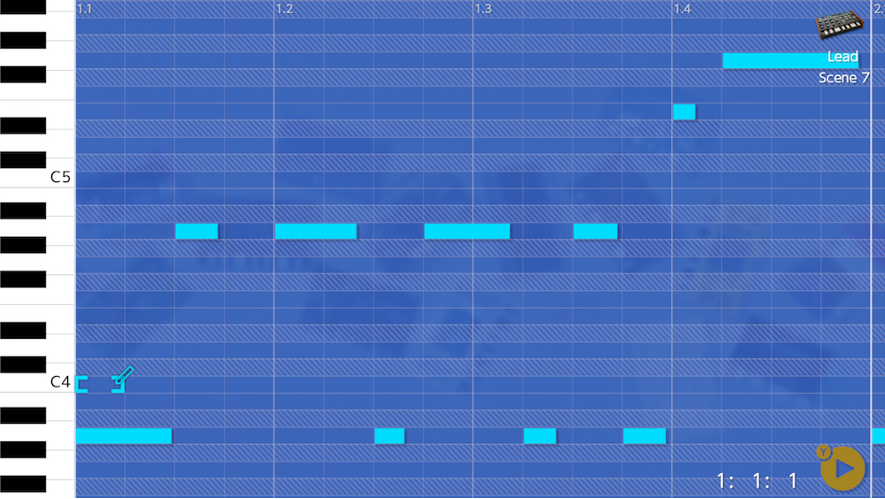
Main Operations
| Place / Remove Note |
Pressing the A button or touch places a note at the current cursor location. If there is already a note there then it is replaced. While the A button is pressed, you can use the left joystick or the direction button to adjust the length of the note by moving left or right. |
| Adjust Note Length |
Move the right joystick left or right to shorten or lengthen the note at the cursor. Hold down ZL button to change the length by the grid. |
| Set Clip Length |
Select “clip length” from the menu to set the number of bars in a clip. The maximum is 8 bars. Also, selecting “Display Range” from the menu will allow you to set the number of bars displayed on the screen. |
| Grid Settings |
By setting the “Grid” in the menu, you can set the grid to display with 8th note or 16th note resolution. Also, when adding notes they automatically snap to the grid. To use triplets, please access the “Grid” menu and select “triplets” or move left and right to turn triplet mode on and off. |
| Editing Velocity (volume) |
Selecting “Edit Velocity” from the menu to display the note velocity (volume). Move the right joystick or touch to adjust the velocity. |
| Edit Automation |
Selecting “Edit Automation” from the menu will display the gadget parameters. Use the right joystick or touch to adjust them up or down. |
Convenient Functions
| Select Range |
To select a range or “Select/Select Range” from the menu, hold down the ZR button and move the cursor. This makes it possible to edit or delete multiple notes simultaneously. |
| Duplicate |
Double the length of the clip, including the notes in the clip. |
| Copy & Paste |
After copying a range, select “paste” from the menu and select a location to paste the information. |
| Undo |
Select “undo” from the menu to undo the previous operation. |
| Move to Different Track / Scene |
Press the L button to enter the shortcut screen, then use the left joystick or the direction buttons to move between tracks or scenes. |
| Display Scale Tones |
On the piano roll screen, notes that are not members of the selected scale are displayed with diagonal lines. It is possible to create a musical tune just be avoiding the notes with hatched lines. |
Gadget / Mixer Screen Operations
This screen allows one to edit and view parameters for gadget instruments and the mixer.
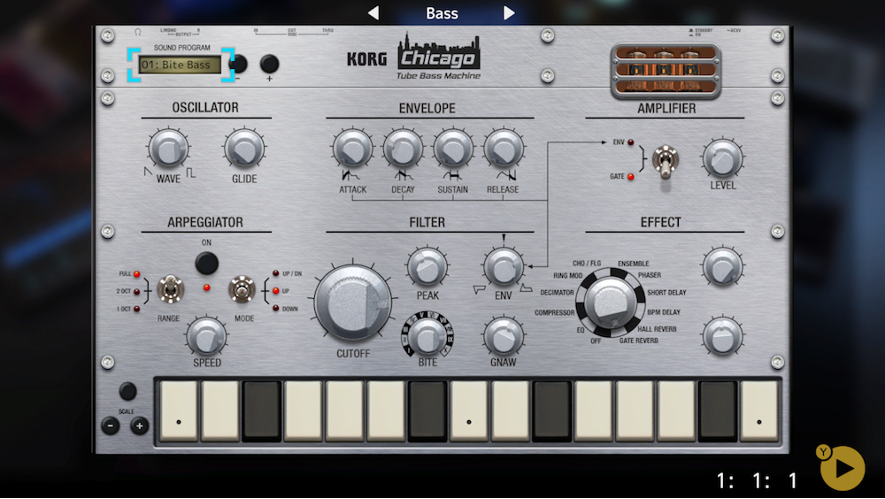
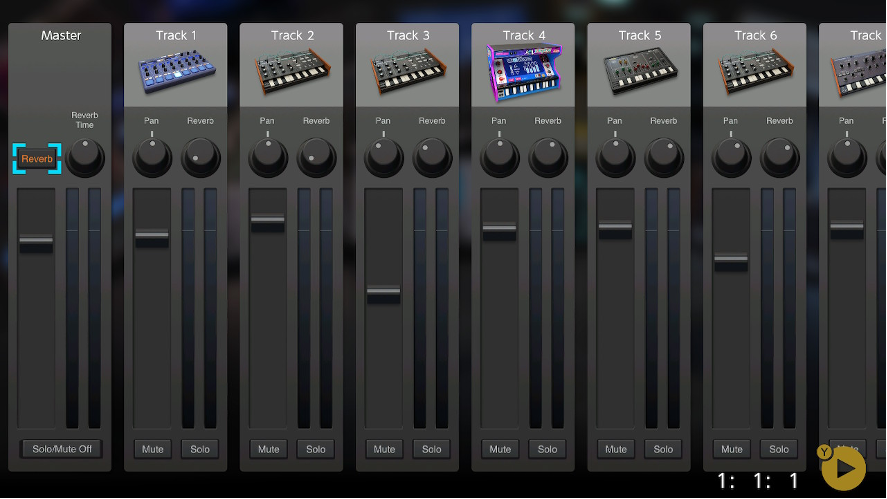
Main Operations
| Knob, Fader Operation |
When a knob or fader is selected, moving the right joystick or touch will adjust the associated parameter. |
| Parameter Adjustment |
Holding down the ZL button when using the right joystick to make parameter adjustments will allow for more detailed setting. |
| Joy-Con Motion Parameter Operation |
When a knob or fader is selected, hold down the A button and move the Joy-Con left, right, up, or down to adjust parameters. |
Convenient Functions
| Preview |
Press the ZR button and the gadget will produce a preview sound. This makes it convenient to adjust the parameters while listening. |
| Save |
To save the current sound, select “Save User Preset” from the menu and assign it a name. Saved user presets may be used in other songs. |
| Delete |
To delete a user preset, select the user preset that you wish to delete and then select “Delete User Preset” from the menu. |
| Motion Performance Controller Performance |
Pressing the “-” button will display then menu, after which you may use the Joy-Con to engage in a motion performance or perform using the controller buttons. |
| Move to |
Press the L button to display the shortcut screen, then use the left joystick or the direction buttons to move to a different track. |
Play/Record Operations
| Loop Playback for Scenes |
Playing back the selected scene repeatedly. Press the L button to enter the shortcut screen and then use the Y button to toggle loop playback on and off. This can also be toggled from “Menu” → “Playback/Recording” → “Scene Loop Playback” |
| Loop Playback for Song |
The entire song is played back repeatedly. Select “Menu” → “Playback/Recording” → “Song Loop Playback” to turn on/off this function |
| Recording |
Long-press the Y button to enter recording mode. Keyboard performances, preview tones, and motion performances on the gadget will be recorded. |
| Recording knob and Fader Operations (automation) |
Operations conducted on the knobs and faders of a gadget while in record mode are also recorded. |
Convenient Functions
| Preview |
Press the ZR button to preview. This is useful for adjusting parameters while listening to the sound. |
| Save User Preset |
When you select "Save User Preset" from the menu, you can name the currently edited voice and save it. You can use the saved user presets in other songs. |
| Delete User Preset |
To delete a user preset, select the user preset you want to delete and then select "Delete User Preset" from the menu. |
| Motion Play |
When you press the- button, a menu will be displayed, and you can play Motion Play by shaking the Joy-Con, or you can play Controller Play using the controller's buttons. |
| Move to another track |
Press the L button to display the shortcut screen, and then use the left analog stick or the directional buttons to quickly move to another track. |
Tech Glossary
| Track |
This represents one part of a song, corresponding to one gadget. A song is made using multiple gadgets, for example a drum track, a bass track, etc. |
| Clip |
A “clip” is a collection of note data. The gadget instruments on each track play the notes in the clip. Each track can be set independently, and each clip may have a different number of bars. |
| Scene |
Horizontal columns are blocks making up a song. The clips on each track are played at the same time. A song is composed of "scenes" such as "INTRODUCTION", "MELODY A", "BRIDGE", etc. in units of bars. |
| Gadget |
This is the name for our compact synthesizers and drum machines. |
| Note |
A note contains pitch and duration information. |
| Velocity |
This controls the volume of a note. |
| Scale / Key |
Set the scale and the key of a given tune. |
| Automation |
Record the movement of a gadget's knobs and sliders. |
| Quantize |
Adjust the timing of recorded notes. |
| User Preset |
Customized gadget sounds created by the user can be saved. |
Other Operations
| Internet Multiplay |
Up to 4 people can compose one song at a time via the Internet. Recording is not possible during Internet Multiplay |
| My First Gadget |
Recommended mode for first-time players. Even if you've never composed a song before, you can make an original in 10 minutes. When you hold the controller horizontally, continuous input of notes is limited to avoid mistakes. |
Exchange Song Data
Created songs can be shared with other users.
| Exchange with near person |
Exchanging song data with someone nearby. |
| Exchange with far person |
Exchange song data via the Internet. |
The following is an explanation of how Player A can send song data to Player B.
| Operation |
Player A | Player B |
| 1 |
From the Mode Selection Screen, select “Data Exchange.” | From the Mode Selection Screen, select “Data Exchange.” |
| 2 |
Select “Send Data and select the song that you wish to send. | |
| 3 |
Select “Receive Data. | |
| 4 | When Player A's name appears, please select it. | |
| 5 | When Player B's name appears as the data receiver, please select it and press the A button. | |
| 6 | When data reception is finished, the song data will be saved. You may then use the “Load Song” function to load the song. |
Settings
| Time Limit |
You can set a time limit. You can continue to play even if you exceed the time limit. |
| Random Starting Gadget |
If ON, gadgets and tones will be selected randomly. |
| Random Tempo |
If ON, Tempo will be set randomly. |
| Random Scale |
If ON, Scale and Key will be set randomly. |
| Scene / Gadget Lock |
When adding or removing a scene or gadget, editing is locked. |
| Note Limit |
Limits the number of notes that can be entered in a single clip. |
Oscilloscope
| IN |
Set the waveform display track. |
| MODE |
Set the waveform display mode. "WAVEFORM" for normal display and "LISSAJOUS" for displaying the right signal on the Y-axis and the left signal on the X-axis. |
| TRIG |
Set the trigger. When it is turned on, the waveform display is stabilized. |
| KEY |
Sets the pitch of the sound in the preview |
| TIME |
Set the width of the waveform display. |
| VOLTS |
Set the height of the waveform display. |
| DIFF |
Set the depth of the waveform display, (only for LISSAJOUS mode) |
| ROT - X |
Sets the X-axis position of the waveform display. |
| ROT - Y |
Sets the Y-axis position of the waveform display. |
Convenient Functions
| Preview |
Press the Y button and the gadget will produce a preview sound. (except MASTER track) |
| Reset |
Press the - button resets the waveform display setting. |
| Auto Rotate |
Press the + button to automatically rotate the waveform. |
Options
| Controller Vibration |
Change controller vibration enable or disable. |
| Note Preview |
When adding or moving a note on the piano roll, that note will trigger. |
| Arcade Controller |
When enabled, you can set the parameters for the cursor position by pressing the A button while connecting the arcade controller. |
| SR Button |
Sets the operation of the SR button when you hold the controller horizontally. |
Other Features
| Solo horizontal grip |
Supports holding the controller horizontally. |
| External USB PC keyboard |
An external USB PC keyboard can be used as a keyboard. You can also control SOLO and MUTE on the mixer screen. |
External USB PC keyboard assign
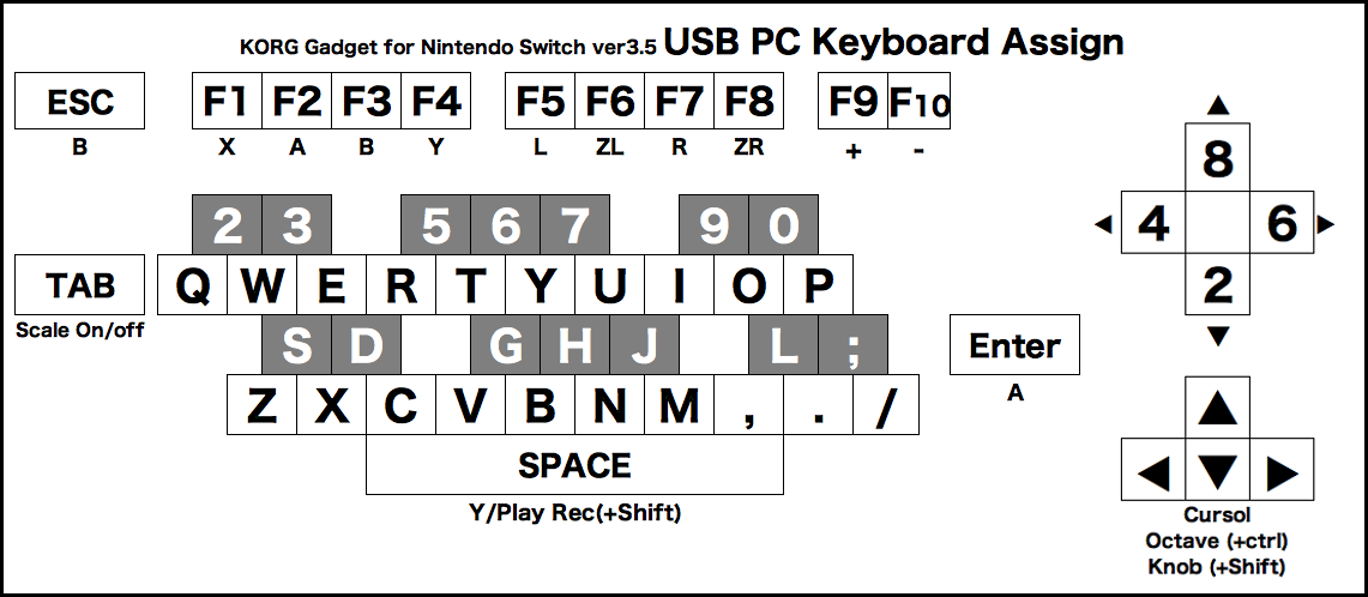
External USB PC keyboard assign (on the Mixer screen)

Gadget Guide
Gadget List
Main Parameters
| Oscillator / VCO | Oscillators are responsible for creating basic sound waves. A variety of oscillators are available for the creation of basic waveforms such sawtooth waves and square waves, PCM waveforms appropriate for the reproduction of acoustic instrument gadgets, and VPMs that make it easy to create brass instrument gadgets. |
|---|---|
| Filter / VCF | Filter reduce or enhance certain ranges of the sounds produced by oscillators to create a more distinctive tone. Filters can include low pass filters that cut the high frequencies to produce a soft tone, high pass filters that cut out the low frequencies to create bright tones, and bandpass filters that reduce only specified frequencies. |
| Amp / VCA | These are used to set the volume, pan, etc. These amplify the sound created by oscillators and filters |
| Envelope Generator | Sounds tend to have a fixed volume curve. For example, when a piano key is struck it is suddenly loud, and then it slowly dissipates.When you release your finger from the keyboard, you will hear a bit of reverberation.Such a curve creates the distinctive sound of each instrument. Such changes can also affect the tone and the pitch of the sound as well as the volume.It is an Envelope Generator that produces these changes. There are EGs that filter the tone color, and EGs that act as amplifiers to change the volume. |
| LFO (Low Frequency Oscillator) | An LFO oscillates the low frequencies. This effect is commonly used to apply vibrato (use an LFO to adjust the pitch up and down), apply a “wah” effect (use an LFO to move the tone color up and down), or to create a tremolo effect (use an LFO to move the volume up and down) |
| Effect / FX | A variety of useful functions can be used to apply various acoustic effects such as distortion, swell, and echo to the sound. You can make the sound completely different from the original sound, and you can also achieve a wide stereo effect. |
Synth Gadget
Marseille

| PROGRAMS | Tap a program name to select it. Using the category buttons on the left, the programs in each category can be displayed. |
|---|---|
| OUTPUT | LEVEL This sets the volume. |
| ENVELOPE | ATTACK This sets the amount of time from note-on until the attack level is reached. DECAY This sets the amount of time from when the attack level is reached until the sustain level is reached. SUSTAIN This sets the sustain level. RELEASE This sets the amount of time that it will take for the level to fall from the sustain level to zero following note-off. |
| EFFECTS | FX SELECT Select the effect to be applied. EFFECT TYPE This selects the effect type. EDIT 1 The parameter that’s controlled by this knob will depend on the effect type. EDIT 2 The parameter that’s controlled by this knob will depend on the effect type. |
| CHORD | This turns the global chord function on or off. When this is turned on, chords along the specified scale can be played. |
Berlin
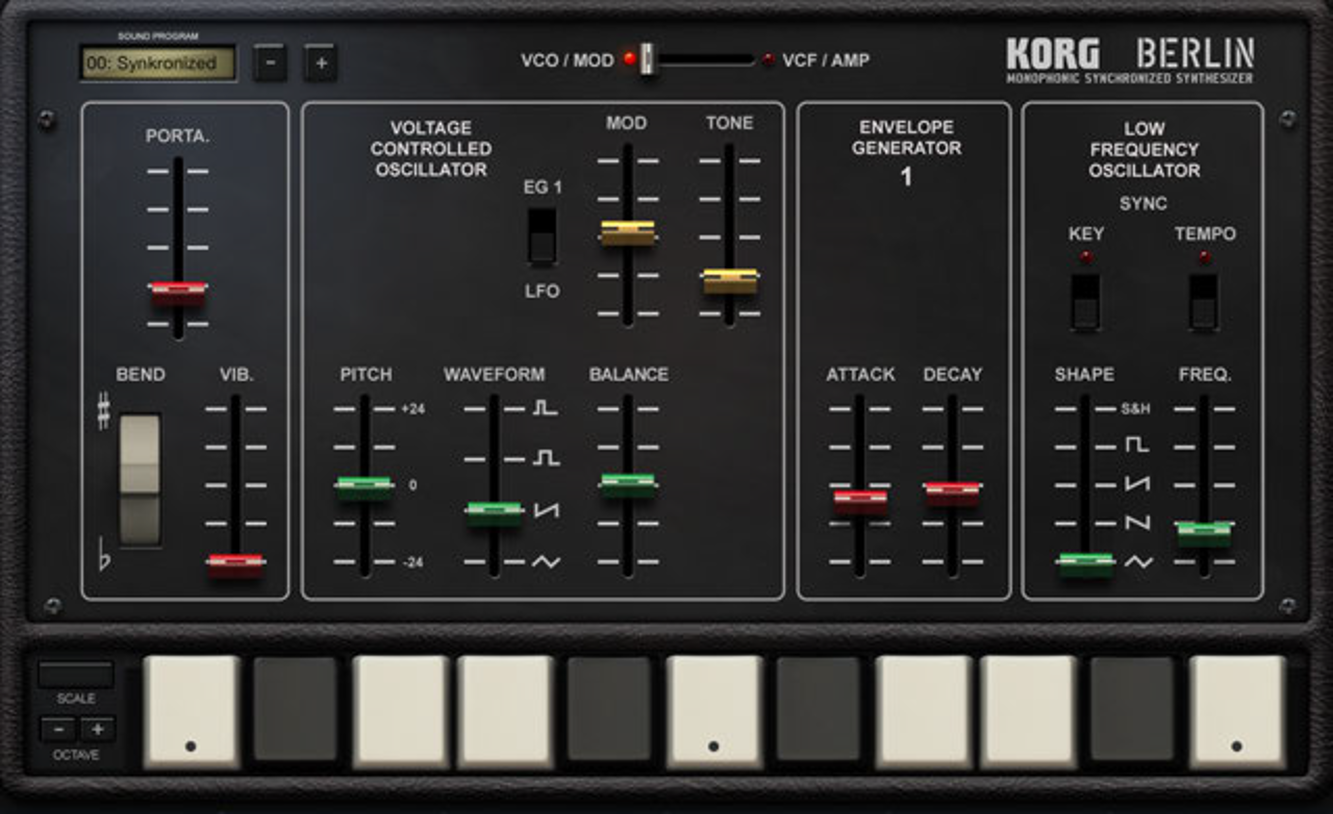
| PORTA. | This sets the pitch glide speed. |
|---|---|
| BEND | This sets the pitch bend. |
| VIB. | This sets the pitch bend. |
| VOLTAGE CONTROLLED OSCILLATOR | PITCH This adjusts the pitch that produced by the oscillator. WAVEFORM This selects the waveform of the oscillator. BALANCE This adjusts the pitch balance of the tone. MOD This sets the depth of the modulation for the oscillator. TONE This adjusts the tone of the oscillator. EG/LFO This selects EG or LFO as the sync modulation source. |
| ENVELOPE GENERATOR | ATTACK This sets the amount of time from note-on until the attack level is reached. DECAY This sets the amount of time until the level becomes 0 after the attack level is reached. |
| LOW FREQUENCY OSCILLATOR | SHAPE This selects the LFO waveform. FREQ This sets the LFO frequency. KEY SYNC If this setting is On, the LFO will be reset at each note-on. TEMPO SYNC If this is On, the LFO frequency will synchronize to the tempo of the song. |
| VOLTAGE CONTROLLED LOW PASS FILTER | FREQ. This sets the cutoff frequency of the filter. RESO. This sets the resonance of the filter. EG This sets the depth of the modulation where the EG1 will affect the cutoff frequency. LFO This sets the depth of the modulation where the LFO will affect the cutoff frequency. KBD This sets the amount of depth that the cutoff frequency will change according to the pitch of the note that is input. |
| VOLTAGE CONTROLLED AMPLIFIER | A (Attack) This sets the amount of time from note-on until the attack level is reached. D (Decay) This sets the amount of time from when the attack level is reached until the sustain level is reached. S (Sustain) This sets the sustain level. R (Release) This sets the amount of time that it will take for the level to fall from the sustain level to zero following note-off. LEGATO This switches the legato on/off. |
| DELAY | TIME This sets the delay time. LEVEL This sets the delay level. SPREAD This sets the width for how far the delay sound will be panned. |
| LEVEL This sets the output volume. |
Chicago

| OSCILLATOR WAVE | This selects the waveform of the oscillator. |
|---|---|
| GLIDE | This sets the pitch glide speed. |
| ENVELOPE | ATTACK This sets the amount of time from note-on until the attack level is reached. DECAY This sets the amount of time from when the attack level is reached until the sustain level is reached. SUSTAIN This sets the sustain level. RELEASE This sets the amount of time that it will take for the level to fall from the sustain level to zero following note-off. AMPLIFIER ENV/GATE This selects the envelope source that will produce change in the volume. LEVEL This sets the volume. |
| ARPEGGIATOR | ON This switches the arpeggiator on/off. RANGE This sets the range of octaves where the arpeggio will be played. MODE This selects the arpeggio type. SPEED This sets the performance speed of the arpeggiator. |
| FILTER | CUTOFF This sets the cutoff frequency of the filter. PEAK This sets the resonance of the filter. This sets the amount of modulation which the EG will use to affect the cutoff frequency. BITE This sets the amount of drive for the filter. GNAW This gives a unique frequency change to the filter input, changing it to an aggressive sound. |
| EFFECT | TYPE This selects the effect type. EDIT 1 The parameter that’s controlled by this knob will depend on the effect type. EDIT 2 The parameter that’s controlled by this knob will depend on the effect type. |
Phoenix

| OSCILLATORS | PITCH 1 This sets the pitch of oscillator 1. PITCH 2 This sets the pitch of oscillator 2. BALANCE This adjusts the volume balance of oscillator 1 and oscillator 2. WAVEFORM 1 This selects the waveform of the oscillator 1. WAVEFORM 2 This selects the waveform of the oscillator 2. PULSE WIDTH This sets the width of pulse wave. PORTA. This sets the pitch glide speed. OSC 2 DETUNE This sets the detuning for oscillator 2. |
|---|---|
| FILTER | FREQUENCY This sets the cutoff frequency of the filter. RESONANCE This sets the resonance of the filter. ENV AMT. This sets the amount of the modulation produced by using the EG to modulate the cutoff frequency. KBD AMT. This sets the amount of depth that the cutoff frequency will change according to the pitch of the note that is input. |
| ENVELOPES | FILTER ENVELOPE, AMPLIFIER ENVELOPE ATTACK This sets the amount of time from note-on until the attack level is reached. DECAY This sets the amount of time from when the attack level is reached until the sustain level is reached. SUSTAIN This sets the sustain level. RELEASE This sets the amount of time that it will take for the level to fall from the sustain level to zero following note-off. |
| PITCH | BEND RANGE This sets the pitch bend range. BEND WHEEL This sets the pitch bend. VIBRATO RATE This sets the vibrato speed. VIBRATO WHEEL This sets the depth of the vibrato. |
| MODULATION | LFO WAVEFORM This selects the LFO waveform. RATE This sets the LFO speed. BPM If this is On, the LFO speed will synchronize to the tempo of the song. KEY If this setting is On, the phase of the LFO will be reset at each note-on. DEPTH PULSE WIDTH This sets the depth of the modulation produced by using LFO to modulate the pulse width. FILTER This sets the depth of the modulation produced by using LFO to modulate the cutoff frequency of the filter. AMP This sets the depth of the modulation produced by using LFO to modulate the volume. |
| DELAY | LEVEL This sets the delay level. TIME This sets the delay time. TONE This sets the tonal character of the delay. |
| MASTER | LEVEL This sets the volume. DETUNE This sets the amount of detuning when “UNISON” is turned on. UNISON This switches the unison on/off. |
Miami

| CARRIER | WAVE This selects the waveform of the carrier oscillator. PITCH This adjusts the pitch produced by the carrier oscillator. LEVEL This sets the volume of the carrier oscillator. SUB This sets the volume of the sub oscillator. |
|---|---|
| X-MOD | WAVE This selects the waveform of the cross-modulation oscillator. DEPTH This sets the depth of the cross-modulation. LEVEL This sets the volume of the cross-modulation oscillator. TUNE This adjusts the pitch produced by the cross-modulation oscillator. |
| FILTER | CUTOFF This sets the cutoff frequency of the filter. CRUSH This adds a unique texture to the filter. WOBBLE This sets the modulation of the filter LFO. SHAPE This selects the LFO waveform. RATE This sets the LFO speed. |
| MASTER | STEREO This adjusts the spread of the output orientation. GLIDE This sets the pitch glide speed. OUTPUT This sets the volume. |
Wolfsburg
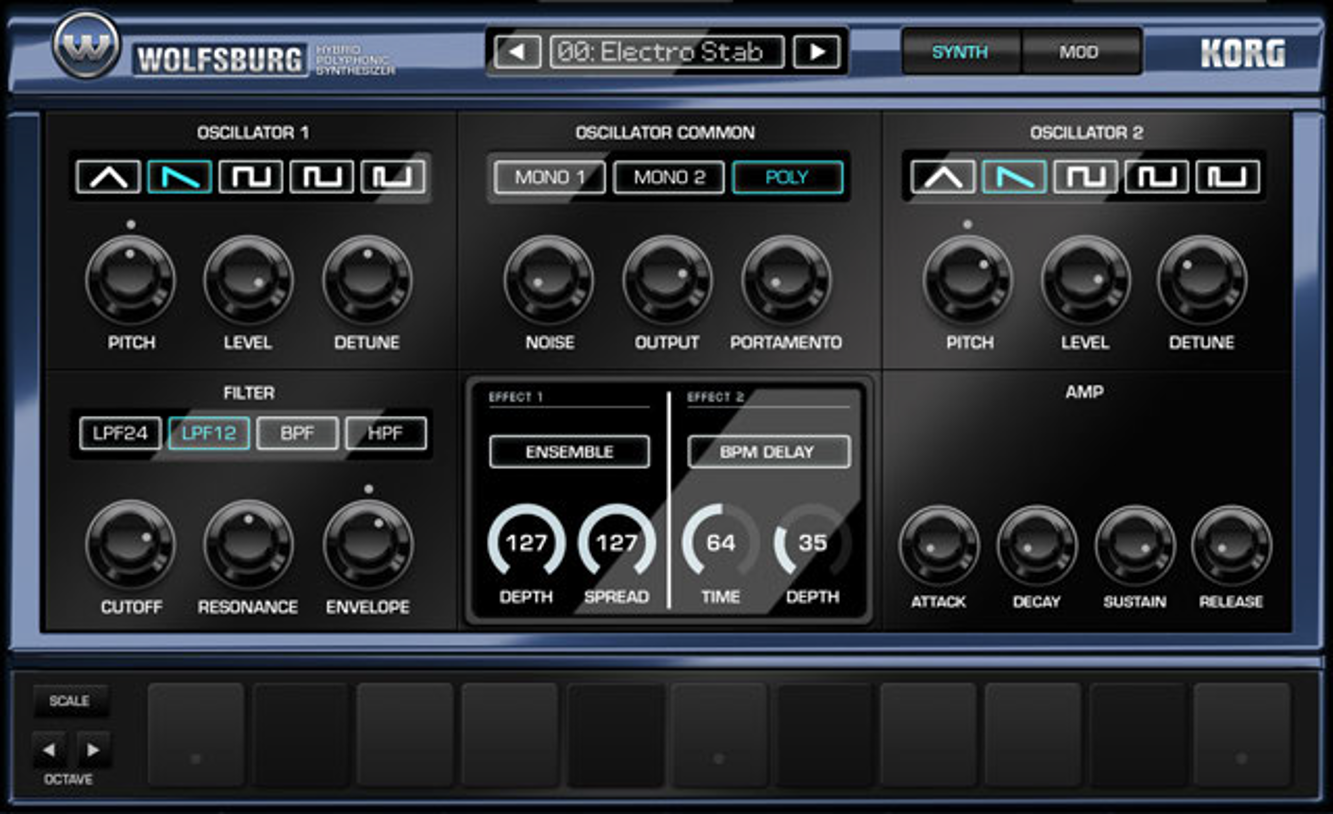
| OSCILLATOR 1, 2 | WAVEFORM This selects the waveform of the oscillator. PITCH This adjusts the pitch produced by the oscillator. LEVEL This sets the volume of the oscillator. DETUNE This sets the amount of detuning. |
|---|---|
| OSCILLATOR COMMON | VOICE MODE This sets how note will be played. NOISE This sets the volume of the noise generator. OUTPUT This sets the volume. PORTAMENTO This sets the pitch glide speed. |
| FILTER | FILTER TYPE This selects the filter type. CUTOFF This sets the cutoff frequency of the filter. RESONANCE This sets the resonance of the filter. ENVELOPE This sets the amount of the modulation to which the EG will affect the cutoff frequency. |
| AMP | ATTACK This sets the amount of time from note-on until the attack level is reached. DECAY This sets the amount of time from when the attack level is reached until the sustain level is reached. SUSTAIN This sets the sustain level. RELEASE This sets the amount of time that it will take for the level to fall from the sustain level to zero following note-off. |
| LOW FREQUENCY OSCILLATOR 1, 2 | WAVEFORM This selects the LFO waveform. BPM SYNC If this is On, the LFO speed will synchronize to the tempo of the song. SPEED This sets the LFO speed. KEY SYNC If this setting is On, the phase of the LFO will be reset at each note-on. |
| MODULATION ENVELOPE | ATTACK This sets the amount of time from note-on until the attack level is reached. DECAY This sets the amount of time from when the attack level is reached until the sustain level is reached. SUSTAIN This sets the sustain level. RELEASE This sets the amount of time that it will take for the level to fall from the sustain level to zero following note-off. |
| MODULATION MATRIX | SOURCE A, B, C, D This sets the modulation source. DESTINATION A, B, C, D This sets the modulation destinations. AMOUNT A, B, C, D This sets the amount of the modulation. |
| EFFECT 1, EFFECT 2 | TYPE This selects the effect type. EDIT 1 The parameter that’s controlled by this knob will depend on the effect type. EDIT 2 The parameter that’s controlled by this knob will depend on the effect type. |
Brussels
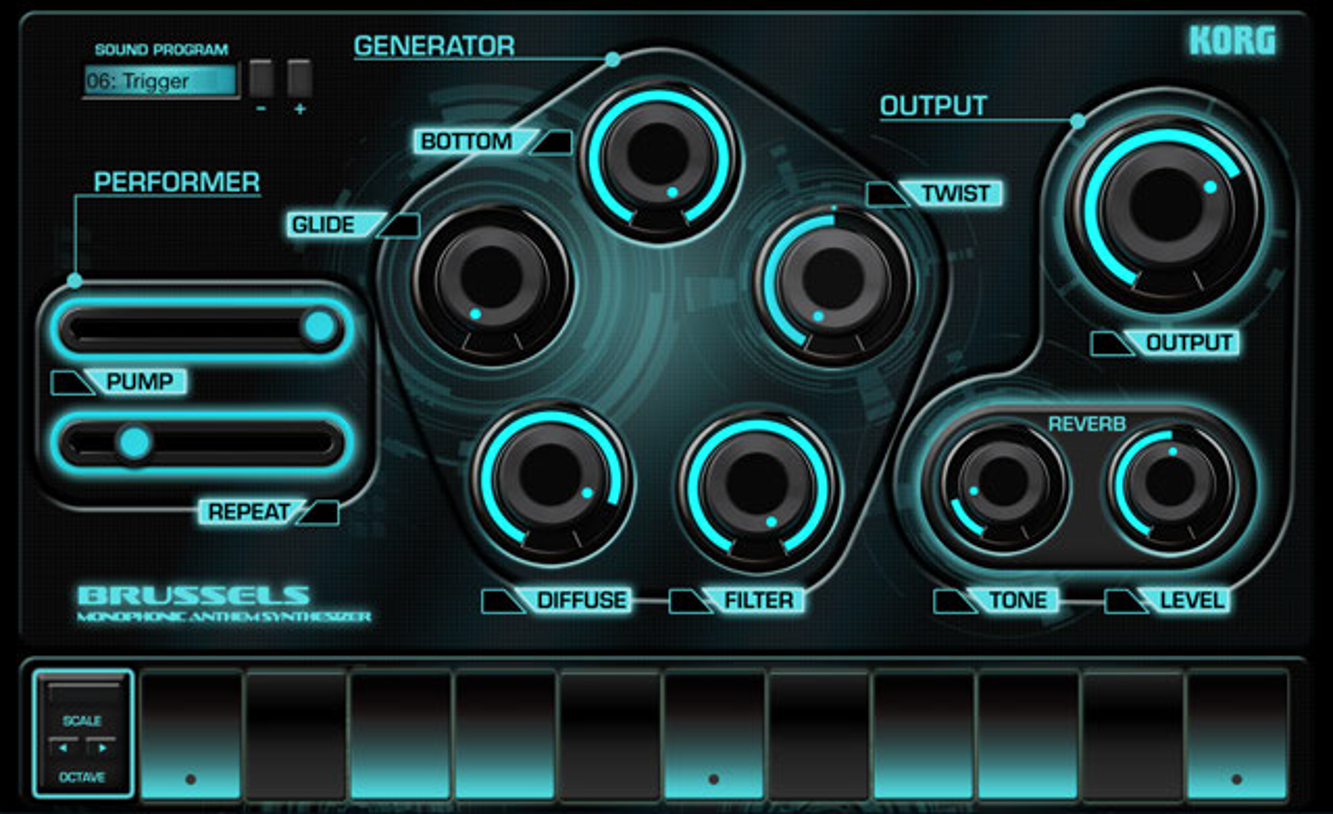
| PERFORMER | PUMP This sets the depth of the pumping effect. REPEAT This sets the depth of the repeat effect. |
|---|---|
| GENERATOR | BOTTOM This sets the volume of the sub oscillator. GLIDE This sets the pitch glide speed. DIFFUSE This sets the spread of the sound. FILTER This sets the cutoff frequency of the filter. TWIST This sets the modulation depth for the oscillator. |
| OUTPUT | LEVEL This sets the overall volume. REVERB TONE This sets the reverberation tone. LEVEL This sets the reverberation level. |
Dublin
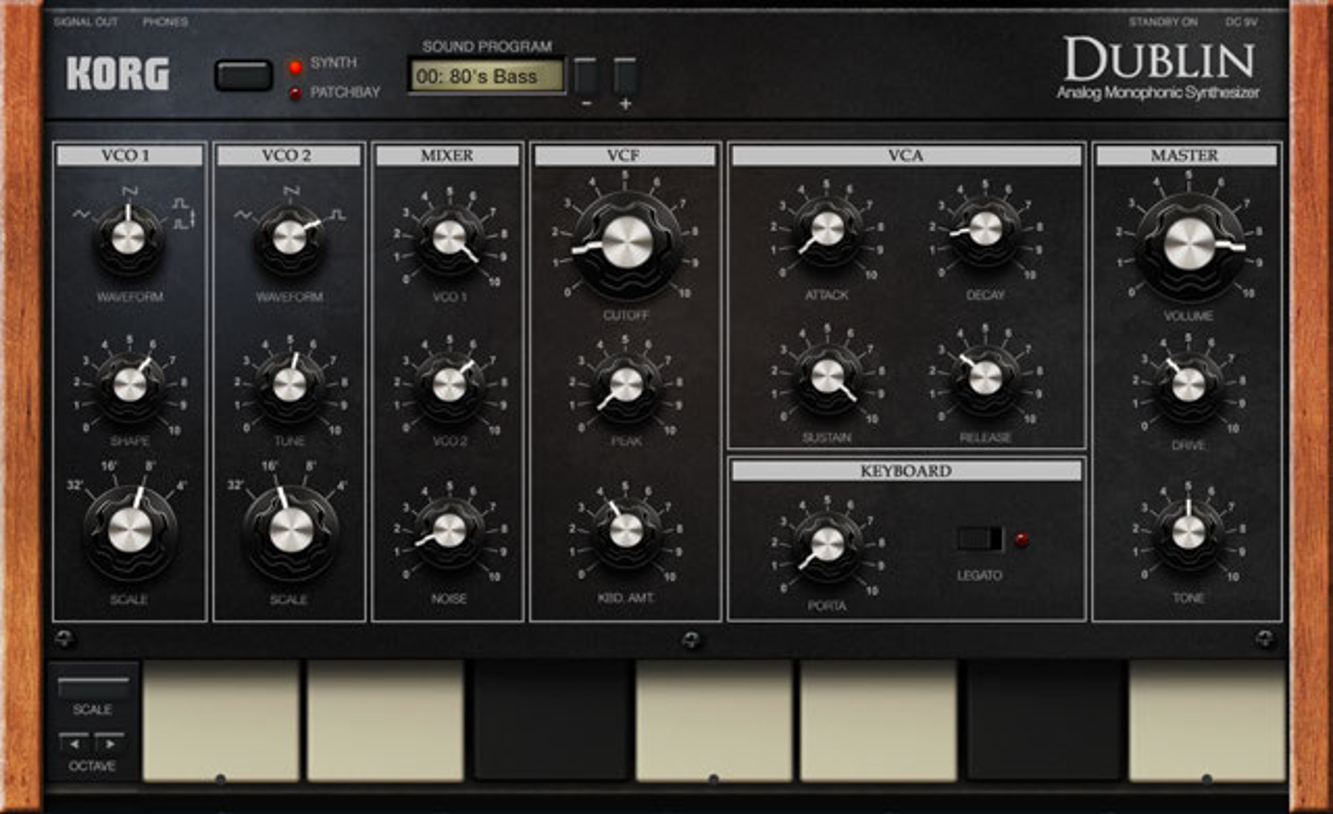
| VCO 1 | WAVEFORM This selects the waveform of oscillator 1. SHAPE This sets the pulse width when the WAVEFORM is set to Pulse. SCALE This adjusts the pitch produced by oscillator 1, in octaves. |
|---|---|
| VCO 2 | WAVEFORM This selects the waveform of oscillator 2. TUNE This adjusts the pitch produced by the carrier oscillator 2. SCALE This sets the pitch produced by the oscillator 2, in octaves. |
| MIXER | VCO 1 This sets the volume of oscillator 1. VCO 2 This sets the volume of oscillator 2. NOISE This sets the volume of the noise generator. |
| VCF | CUTOFF This sets the cutoff frequency of the filter. PEAK This sets the resonance of the filter. KBD AMT This sets the amount of depth that the cutoff frequency will change according to the pitch of the note that is input. |
| VCA | ATTACK This sets the amount of time from note-on until the attack level is reached. DECAY This sets the amount of time it will take for the level to change from the attack level to the sustain level. SUSTAIN This sets the sustain level. RELEASE This sets the amount of time that it will take for the level to fall from the sustain level to zero following note-off. |
| KEYBOARD | PORTA This sets the pitch glide speed. LEGATO When this is turned on, each note is played legato when sliding along the keyboard. |
| MASTER | VOLUME This sets the volume. DRIVE This sets the amount of the output drive. TONE This adjusts the tone. |
| MG 1, MG 2 | MG OUT To connect patch cables and select the modulation destination for the MG (modulation generator). AMOUNT This sets the amount of modulation for the MG (Modulation Generator). BPM If this is On, the frequency of the waveform will synchronize to the tempo of the song. KEY If this setting is On, the waveform will be reset at each note-on. WAVEFORM This selects the waveform of the MG (Modulation Generator). FREQ This sets the frequency of the waveform. |
| ENVELOPE GENERATOR | EG OUT To connect patch cables and select the modulation destination for the EG. AMOUNT This sets the amount of modulation for the EG. ATTACK This sets the amount of time from note-on until the attack level is reached. DECAY This sets the amount of time from when the attack level is reached until the sustain level is reached. SUSTAIN This sets the sustain level. RELEASE This sets the amount of time that it will take for the level to fall from the sustain level to zero following note-off. |
| PATCHBAY INPUTS This sets the modulation destinations for MG1, MG2 and the EG. Any of the following parameters can be set as the modulation destination. |
VCO 1 SHAPE Pulse width when PULSE is selected as the waveform in VCO1 VCO 1 & VCO 2 PITCH The pitch of VCO 1 and VCO 2 VCO 2 PITCH The pitch of VCO 2 VCO 1 LEVEL The volume of VCO1 VCO 2 LEVEL The volume of VCO2 NOISE LEVEL The volume of noise VCF CUTOFF Cutoff frequency of filter (VCF) VCA GAIN Total volume MG1 FREQ Speed of MG1 MG2 FREQ Speed of MG2 |
Kiev

| OSC MORPHER | TOUCH-PAD This adjusts the volume balance of oscillator A, B, C, and D. A/B DEPTH This sets the amount that the volume balance of oscillators A and B are changed. A/B SPEED This sets the speed at which the volume balance of oscillators A and B are changed. C/D DEPTH This sets the amount that the volume balance of oscillators C and D are changed. C/D SPEED This sets the speed at which the volume balance of oscillators C and D are changed. |
|---|---|
| OSCILLATOR | WAVEFORM A This selects the waveform of the oscillator A. WAVEFORM B This selects the waveform of the oscillator B. WAVEFORM C This selects the waveform of the oscillator C. WAVEFORM D This selects the waveform of the oscillator D. PITCH A This adjusts the pitch of the oscillator A. PITCH B This adjusts the pitch of the oscillator B, in half-steps. PITCH C This adjusts the pitch of the oscillator C, in half-steps. PITCH D This adjusts the pitch of the oscillator D, in half-steps. TUNE B This adjusts the pitch of the oscillator B, in semitone-steps (±100 cents). TUNE C This adjusts the pitch of the oscillator C, in semitone-steps (±100 cents). TUNE D This adjusts the pitch of the oscillator D, in semitone-steps (±100 cents). |
| FILTER | TYPE This selects the filter type. ENVELOPE This sets the amount of the modulation which the EG will use to affect the cutoff frequency. ATTACK This sets the amount of time from note-on until the attack level is reached. DECAY This sets the amount of time from when the attack level is reached until the sustain level is reached. SUSTAIN This sets the sustain level. RELEASE This sets the amount of time that it will take for the level to fall from the sustain level to zero following note-off. TOUCH-PAD CUTOFF This sets the cutoff frequency of the filter. PEAK This sets the resonance of the filter. |
| EFFECT | TYPE This sets the effect type. EDIT 1 The parameter that’s controlled by this knob will depend on the effect type. EDIT 2 The parameter that’s controlled by this knob will depend on the effect type. |
| MASTER | LEVEL This sets the volume. |
| AMPLIFIER ENVELOPE | ATTACK This sets the amount of time from note-on until the attack level is reached. DECAY This sets the amount of time from when the attack level is reached until the sustain level is reached. SUSTAIN This sets the sustain level. RELEASE This sets the amount of time that it will take for the level to fall from the sustain level to zero following note-off. |
Chiang Mai
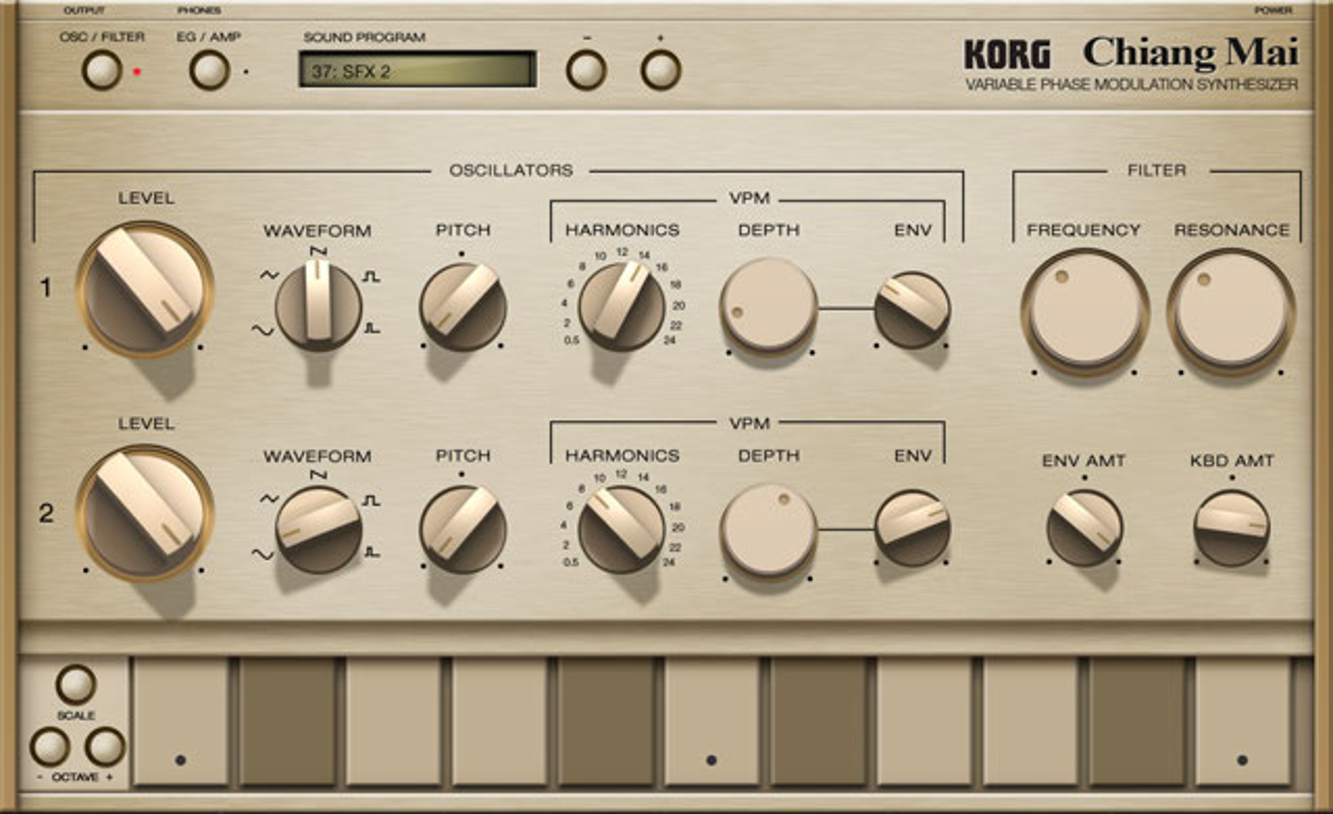
| OSCILLATORS (1, 2) | LEVEL This sets the volume of the oscillator. WAVEFORM This selects the waveform of the oscillator. PITCH This adjusts the pitch produced by the oscillator. HARMONICS This sets the frequency of the VPM (Variable Phase Modulation) modulator as a harmonic multiple of oscillator. DEPTH This sets the depth of VPM. ENV This sets the amount of modulation which the EG will use to affect the depth of the VPM. |
|---|---|
| FILTER | FREQUENCY This sets the cutoff frequency of the filter. RESONANCE This sets the resonance of the filter. |
| ENV AMT | This sets the amount of the modulation which the EG will use to affect the cutoff frequency. |
| KBD AMT | This sets the amount of depth that the cutoff frequency will change according to the pitch of the note that is input. |
| ENVELOPE (FILTER, AMPLIFIER) | ATTACK This sets the amount of time from note-on until the attack level is reached. DECAY This sets the amount of time from when the attack level is reached until the sustain level is reached. SUSTAIN This sets the sustain level. RELEASE This sets the amount of time that it will take for the level to fall from the sustain level to zero following note-off. |
| CHORUS | SPEED This sets the speed of the effect DEPTH This sets the depth of the effect. |
| DELAY | TIME This sets the delay time. LEVEL This sets the delay level. |
| OUTPUT | LEVEL This sets the volume. |
Helsinki
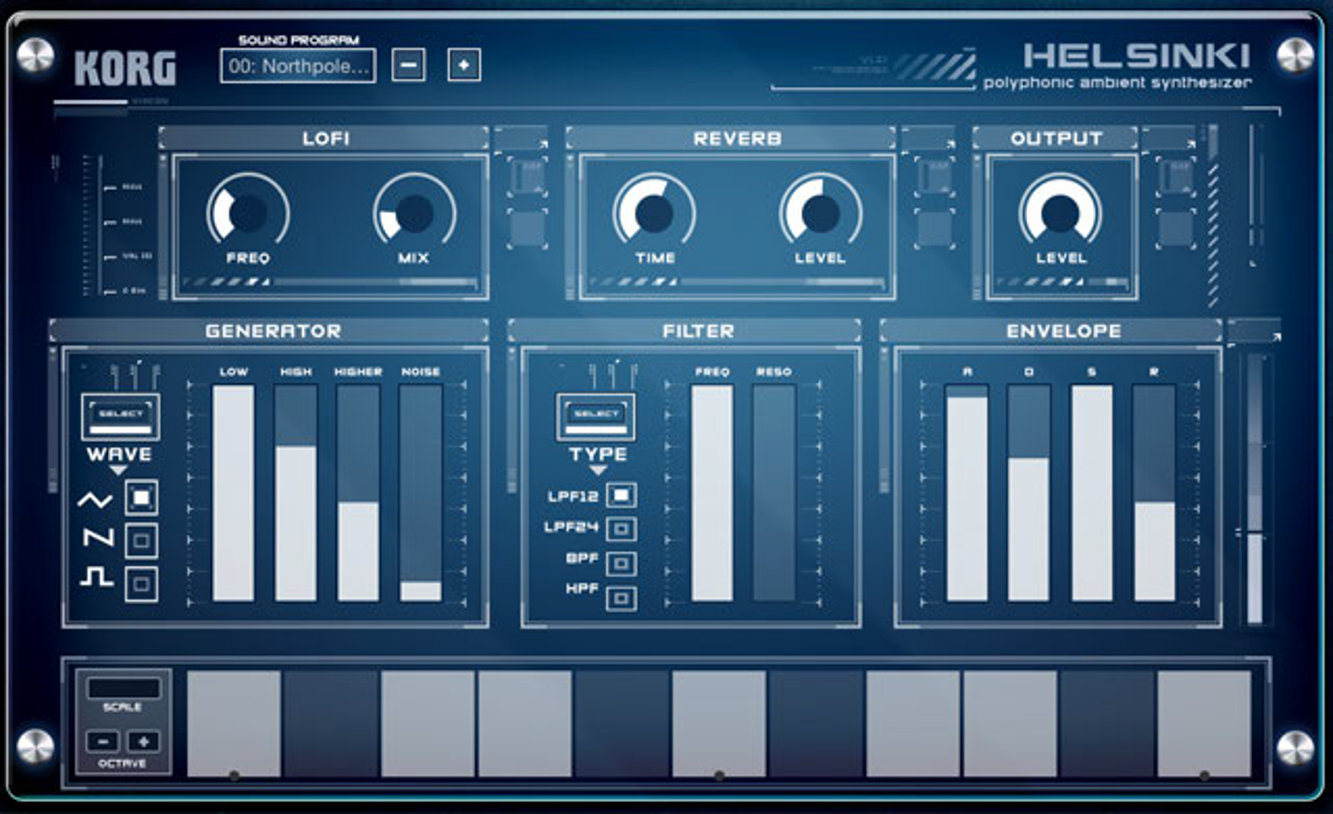
| LOFI | FREQ This sets the roughness of the sound and the frequency of the digital meter. MIX This sets the amount of the effect sound mixed with the dry sound. |
|---|---|
| REVERB | TIME This sets the reverberation time. LEVEL This sets the reverberation level. |
| OUTPUT | LEVEL This sets the volume. |
| GENERATORS | WAVE This selects the waveform of the oscillator. LOW This sets the low range level of the oscillator. HI This sets the high range level of the oscillator. HIGHER This sets the higher range level of the oscillator. NOISE This sets the volume of the noise generator. |
| FILTER | TYPE This selects the filter type. FREQ This sets the cutoff frequency of the filter. RESO This sets the resonance of the filter. |
| ENVELOPE | A This sets the amount of time from note-on until the attack level is reached. D This sets the amount of time from when the attack level is reached until the sustain level is reached. S This sets the sustain level. R This sets the amount of time that it will take for the level to fall from the sustain level to zero following note-off. |
Kingston
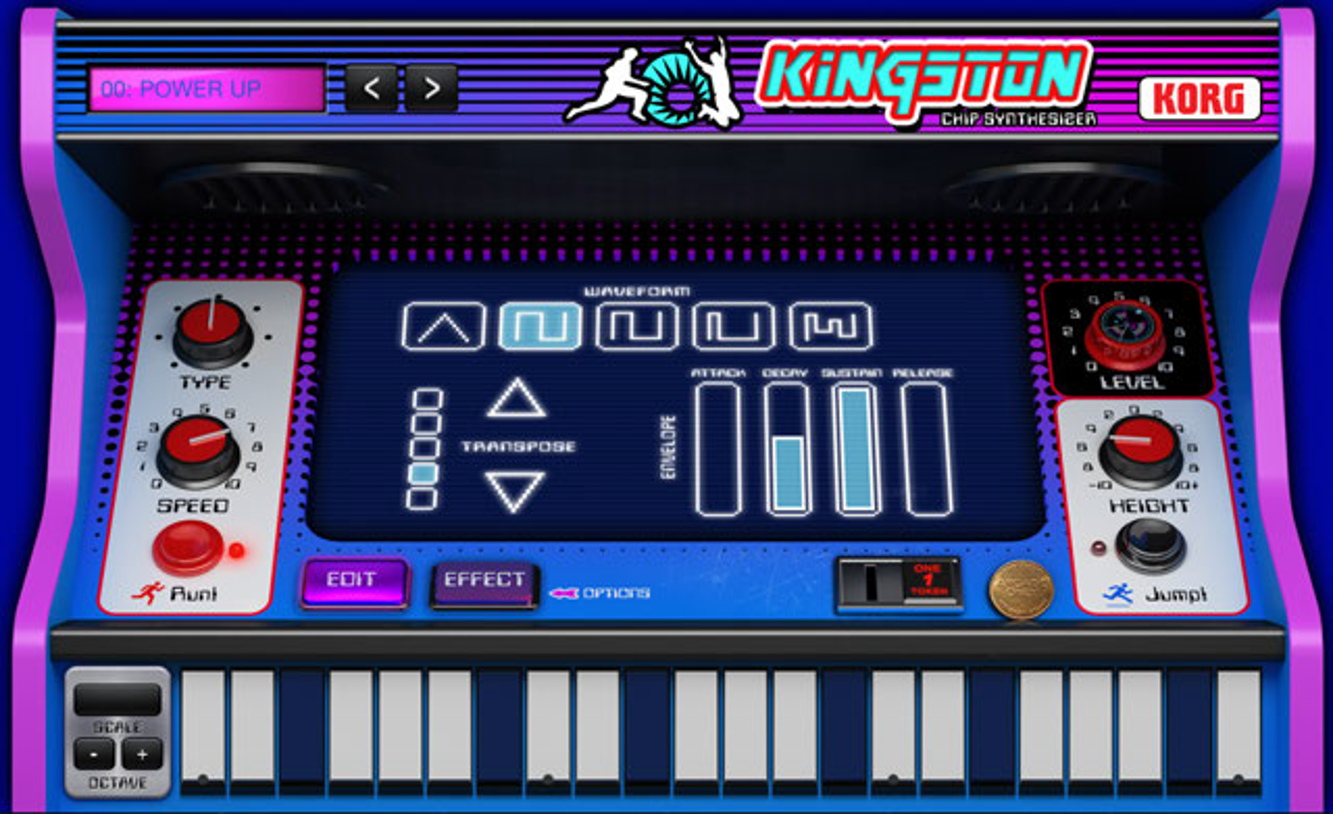
| RUN! | TYPE This selects the run type. SPEED This sets the performance speed of the run. ON/OFF This switches the run on/off. |
|---|---|
| EDIT | WAVEFORM This selects the waveform of the oscillator. TRANSPOSE This adjusts the pitch of the oscillator. ENVELOPE ATTACK This sets the amount of time from note-on until the attack level is reached. DECAY This sets the amount of time from when the attack level is reached until the sustain level is reached. SUSTAIN This sets the sustain level. RELEASE This sets the amount of time that it will take for the level to fall from the sustain level to zero following note-off. |
| EFFECT | TYPE This sets the effect type. EDIT 1 The parameter that’s controlled by this knob will depend on the effect type. EDIT 2 The parameter that’s controlled by this knob will depend on the effect type. |
| LEVEL | This sets the volume. |
| JUMP! | HEIGHT This sets the height of jump. ON/OFF This switches the jump on/off. |
Kamata
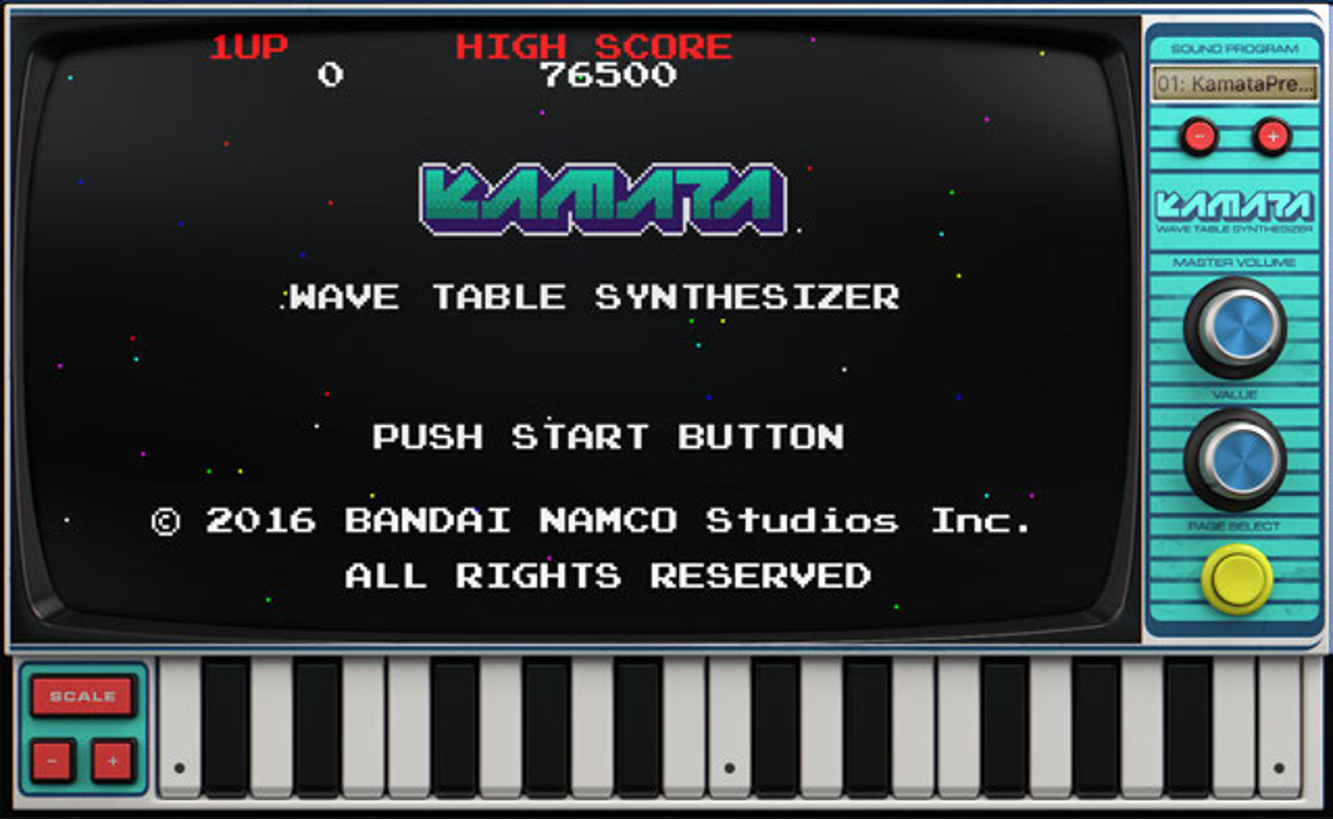
| MASTER VOLUME | This sets the value of the selected parameter. |
|---|---|
| VALUE | This sets the volume. |
| PAGE SELECT | This accesses the page. |
| WAVE BANK | This selects the wavetable. |
| DETUNE | This sets the amount of detuning. |
| NOISE | This sets the volume of the noise generator. |
| AMP ENV | AT (Attack Time) This sets the amount of time from note-on until the attack level is reached. DT (Decay Time) This sets the amount of time from when the attack level is reached until the sustain level is reached. SL (Sustain Level) This sets the sustain level. RT (Release Time) This sets the amount of time that it will take for the level to fall from the sustain level to zero following note-off. |
| PITCH ENV | AT (Attack Time) This sets the amount of time from note-on until the attack level is reached. DT (Decay Time) This sets the amount of time from when the attack level is reached until the sustain level is reached. RT (Release Time) This sets the amount of time that it will take for the level to fall from the sustain level to zero following note-off. SL (Start Level) This sets the start level. AL (Attack Level) This sets the amount of time from note-on until the attack level is reached. SL (Sustain Level) This sets the sustain level. RL (Release Level) This sets the amount of time that it will take for the level to fall from the sustain level to zero following note-off. |
| DELAY | TIME This sets the delay time. LEVEL This sets the delay level. COUNT This sets the number of times the delay sound is repeated. |
| REVERB | TIME This sets the reverb time. LEVEL This sets the reverb level. |
| LFO1-AMP | WAVE This selects the waveform of the LFO1. DEPT (Depth) This sets the depth of the LFO1. DELT (Delay Time) This sets the time from note-on until the LFO1 starts. RATE This sets the LFO1 speed. |
| LFO2-PITCH | WAVE This selects the waveform of the LFO2. DEPT (Depth) This sets the depth of the LFO2. DELT (Delay Time) This sets the time from note-on until the LFO2. RATE This sets the LFO2 speed. |
| PORTAMENTO | MODE This switches the mode between Poly/Mono. TIME This sets the portamento time. |
| CONTROL | MOD-WHEEL This sets the pitch and amp to be controlled with a modulation wheel. PITCHBEND This sets the change range for the pitch bend. |
Ebina
This is a synth gadget inspired by the Darius arcade cabinet and its distinctive three-screen design. Synth sounds have been recorded from arcade games such as Darius and The Ninja Warriors. Through collaboration with Taito, we are reproducing FM tone generator sounds (mostly), successfully reproducing sounds of these legendary arcade games.

| OSC | PCM SELECT This selects the waveform of the oscillator. CH 1 LEVEL This sets the oscillator volume. CH 2 LEVEL This sets the oscillator delay and detune volume. CH 3 LEVEL This sets the oscillator delay and detune volume. DETUNE This sets the amount of the oscillator delay. DELAY This sets the oscillator delay time. DELAY BPM SYNC If this is On, the oscillator delay time will synchronize to the tempo of the song. |
|---|---|
| PITCH | EG INT This sets the depth of the modulation where the EG will affect the pitch. LFO DEPTH This sets the depth of the modulation where the LFO will affect the pitch. OCTAVE This adjusts the pitch produced by oscillator, in octaves. PORTAMENTO This sets the pitch glide speed. EG START LEVEL This sets the start level for the pitch EG. EG ATTACK TIME This sets the attack time for the pitch EG. EG ATTACK LEVEL This sets the attack level for the pitch EG. EG DECAY TIME This sets the decay time for the pitch EG. |
| AMP | OUTPUT LEVEL This sets the volume. LFO DEPTH This sets the depth of the modulation where the LFO will affect the volume. EG ATTACK TIME This sets the amount of time from note-on until the attack level is reached. EG DECAY TIME This sets the amount of time from when the attack level is reached until the sustain level is reached. EG SUSTAIN LEVEL This sets the sustain level. EG RELEASE TIME This sets the amount of time that it will take for the level to fall from the sustain level to zero following note-off. |
| FLT | CUTOFF This sets the cutoff frequency of the filter. RESONANCE This sets the resonance of the filter. EG INT This sets the depth of the modulation where the EG will affect the filter. LFO DEPTH This sets the depth of the modulation where the LFO will affect the filter. EG ATTACK TIME This sets the attack time for the filter EG. EG DECAY TIME This sets the decay time for the filter EG. EG SUSTAIN LEVEL This sets the sustain level for the filter EG. EG RELEASE TIME This sets the release time for the filter EG. |
| LFO | WAVEFORM This selects the LFO waveform. FREQUENCY This sets the LFO speed. BPM SYNC If this is On, the LFO speed will synchronize to the tempo of the song. KEY SYNC If this setting is On, the phase of the LFO will be reset at each note-on. FADE-IN Sets the amount of time for the LFO to reach its maximum depth. |
| MISC | EFFECT TYPE This selects the effect type. EFFECT EDIT 1 The parameter that’s controlled by this knob will depend on the effect type. EFFECT EDIT 2 The parameter that’s controlled by this knob will depend on the effect type. VOICE MODE This sets how note will be played. BEND RANGE This sets the pitch bend. |
Drum Gadget
London
This is a drum sound module gadget designed specifically for dance music. True to its simple, straightforward looks, it instantly gives you a performance-ready drum kit. There are more than 400 samples that will cover your needs for a variety of dance music formats including Electro, Minimal, Dubstep and so on. It also provides three effects that you can use on each part, as well as a master effect.
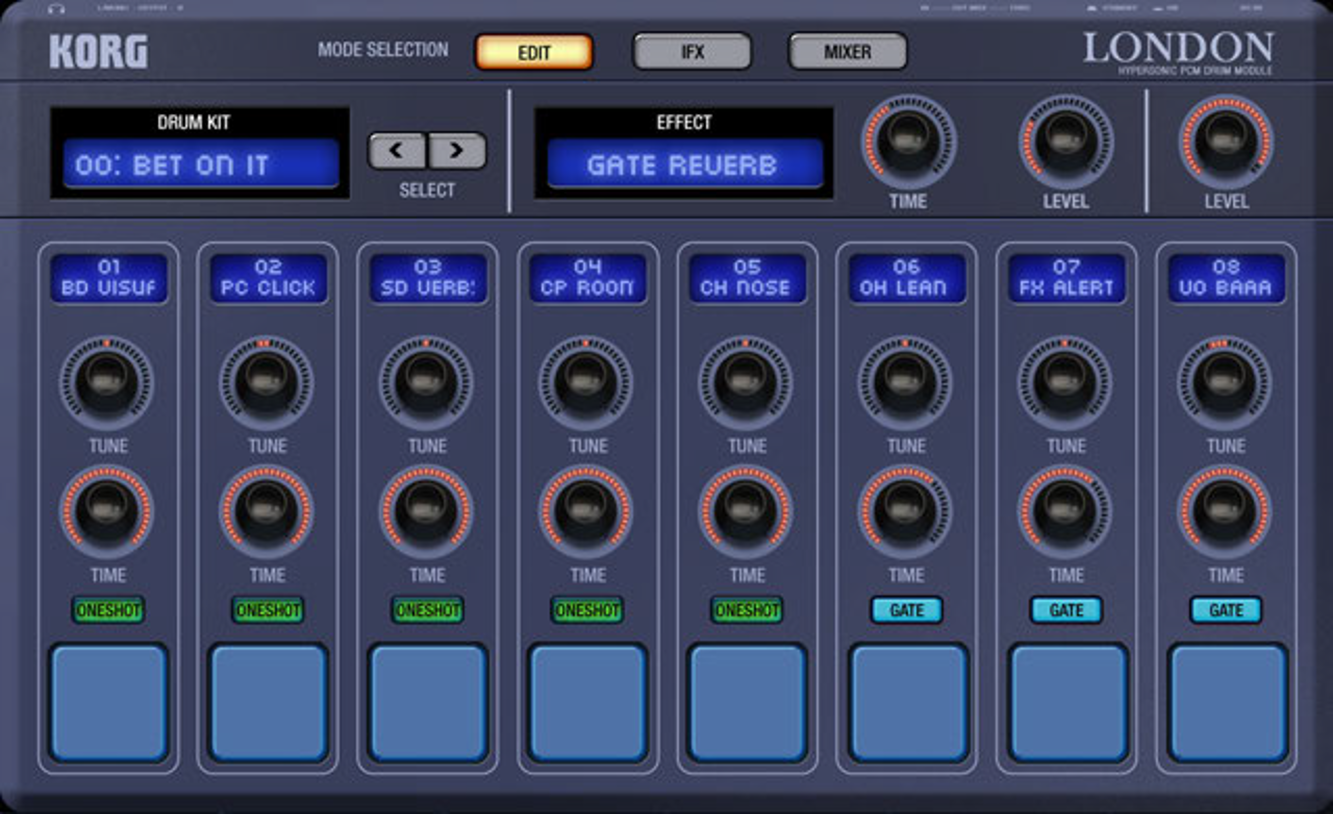
| PART 1...8 EDIT | WAVEFORM This selects the waveform that will be used by each part. You can play the waveform with the ZR button before setting. TUNE This adjusts the pitch for each part. TIME This sets the decay time for each part when TRIGGER is set to ONESHOT. This sets the release time for each part when TRIGGER is set to GATE. TRIGGER This selects the trigger type for each part. |
|---|---|
| PART 1...8 FX | Punch This sets an attack-emphasizing effect for the output signal of a part. Low Boost This sets the boost for the low range. REV (Reverse) This switches the reverse on/off for each part. MFX (Master Effect Send) This sets whether or not the sound for the part is sent to the master effect. |
| PART 1...8 MIXER | Pan This sets the panning value for each part. M (Mute) This determines whether or not the part will sound. Group This groups parts. Parts that share the same settings are combined into one group and the last note is given priority, producing a monophonic sound. This is effective, for example, when playing with the closed and open sounds of the hi-hat grouped. LEVEL This sets the volume for each part |
| EFFECT | TYPE This sets the effect type. EDIT 1 The parameter that’s controlled by this knob will depend on the effect type. EDIT 2 The parameter that’s controlled by this knob will depend on the effect type. |
| MASTER | LEVEL This sets the volume. |
Tokyo

| BD201 | WAVE This selects the waveform. TUNE This sets the pitch. DECAY This sets the length of the sound. BEND This sets the amount of bend. BOOST This sets the amount of low boost. LEVEL This sets the volume. PAN This sets the paning value. |
|---|---|
| SD302 | TUNE This sets the pitch. DECAY This sets the length of the sound. NOISE This sets the tonal character and modulation of the noise. SNAPPY This sets the amount of noise in the snare. PUNCH This emphasizes the attack. LEVEL This sets the volume. PAN This sets the paning value. |
| TOM404 | TUNE This sets the pitch. DECAY This sets the length of the sound. BEND This sets the amount of bend. NOISE This sets the amount of noise. LEVEL This sets the volume. PAN This sets the paning value. |
| PCS503 | TUNE This sets the pitch. DECAY This sets the length of the sound. SHAPE This selects the modulation type. DEPTH This sets the modulation depth. SPEED This sets the modulation speed. LEVEL This sets the volume. PAN This sets the paning value. |
Amsterdam

| EFFECT | TYPE This selects the effect type EDIT 1 The parameter that’s controlled by this knob will depend on the effect type. EDIT 2 The parameter that’s controlled by this knob will depend on the effect type. |
|---|---|
| MASTER | MASTER This sets the overall volume. |
| PART 1...4 | LEVEL This sets the volume for each part. PAN This sets the panning value for each part. WAVE This selects the waveform for each part. TUNE This sets pitch for each part. TIME This sets the decay time for each part. EG MODE This sets the decay time for each part. FX SEND This switches the send on/off for effect. REVERSE This switches the wave plays in reverse. |
Otorii
(Additional Paid Content)
Concentrating on arcade games that achieved popularity in the 80s, such as Out Run and After Burner, drumming sound and sound effects have been newly sampled from original equipment. This nostalgic design, inspired by the Mega Drive and with a 16-bit logo, is a distinctive rhythm sound generator gadget.

| MASTER VOL | This sets the volume. |
|---|---|
| PAGE | Set the parameters to be edited. |
| INFO | Displays the game information for the selected tone |
| PAGE 1 | LEVEL This sets the volume for the selected part. PAN This sets the panning value for the selected part. DECAY This sets the decay time for the selected part. PITCH This sets the pitch for the selected part. REPEAT Set the time for the selected part to be played repeatedly. |
| PAGE 2 | STRAT SAMPLE Set the sample playback start position for the selected part. SAMPLE LENGTH Set the end of sample playback position for the selected part. ONE SHOT If this is On, it plays back to the end of the sample playback position of the selected part, regardless of the length of the note. FX SEND This switches the send on/off for effect. GROUP This groups parts. Parts that share the same settings are combined into one group and the last note is given priority, producing a monophonic sound. This is effective, for example, when playing with the closed and open sounds of the hi-hat grouped. SAMPLE SELECT This selects the waveform for the selected part.. REV(in the SAMPLE SELECT screen) This switches the reverse on/off for the selected part. |
| FX | EDIT1 The parameter that’s controlled by this knob will depend on the effect type. EDIT2 The parameter that’s controlled by this knob will depend on the effect type. EFFECT TYPE This sets the effect type. |
Effects
| EFFECT TYPE |
EDIT 1 | EDIT 2 | |
| Bypass |
No effect | ||
| Peak EQ |
Emphasizes a specific frequency | Frequency | Gain |
| 2Band EQ |
Emphasizes the low or high frequency | Low Gain | High Gain |
| LPF |
Shaves off the higher frequency | Cutoff Frequency | Resonance |
| HPF |
Shaves off the lower frequency | Cutoff Frequency | Resonance |
| BPF |
Makes a specific frequency sound | Cutoff Frequency | Resonance |
| Comb Filter |
Emphasizes a specific frequency to make it sound unique | Frequency | Feedback |
| Compressor |
Adjusts the volume of the sound and makes it more powerful | Sens | Attack |
| Tube Drive |
Adds a vacuum tube - like warmth and distortion | Tube Gain | - |
| Distortion |
Adds distortion and power | Gain | Level |
| Decimator |
Gives an old digital sound | Frequency | Balance |
| Ring Mod |
Creates a metallic tone | Frequency | Balance |
| Talk Mod |
Gives the sound of the human voice | Formant | Offset |
| Cho/Flg |
Gives thickness and swell | Speed | Depth |
| Ensemble | Gives depth and breadth | Depth | Spread |
| Phaser | Gives the sound swell | Frequency | Depth |
| Auto Pan | Shakes the sound to the left or right | Frequency | Depth |
| Tremolo | Modulates the volume | Frequency | Depth |
| Pump | Makes the sound bouncy | Frequency | Attack |
| Slicer | Slices the sound | Frequency | Holdtime |
| GrainShift | Makes the sound grainy | Speed | Balance |
| Short Delay | Adds an echo | Time | Depth |
| BPM Delay | Adds a tempo matching echo | Time | Depth |
| Room Reverb | Adds the echo of the room | Time | Level |
| Hall Reverb | Adds the echo of the hall | Time | Level |
| Gate Reverb | Adds the unusual echo | Time | Level |
